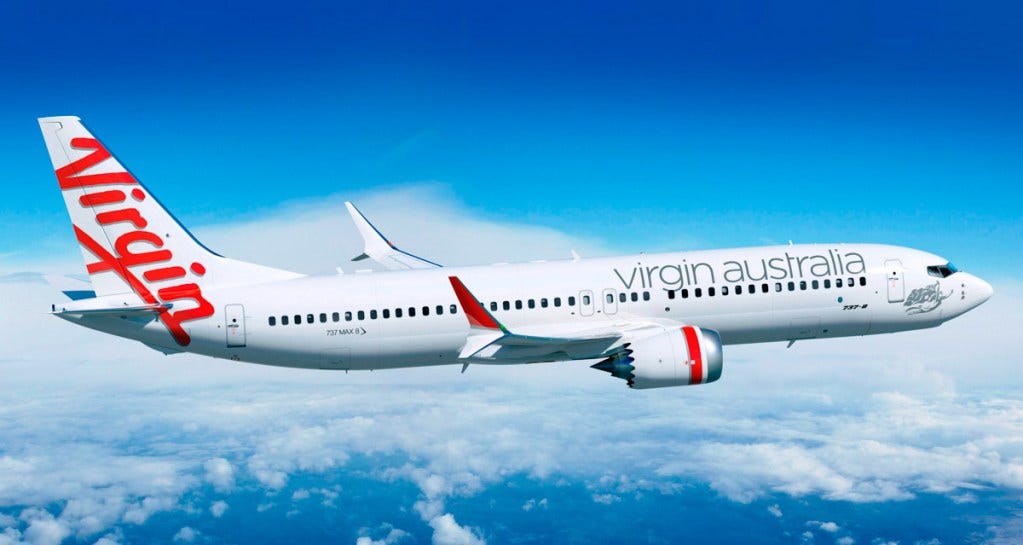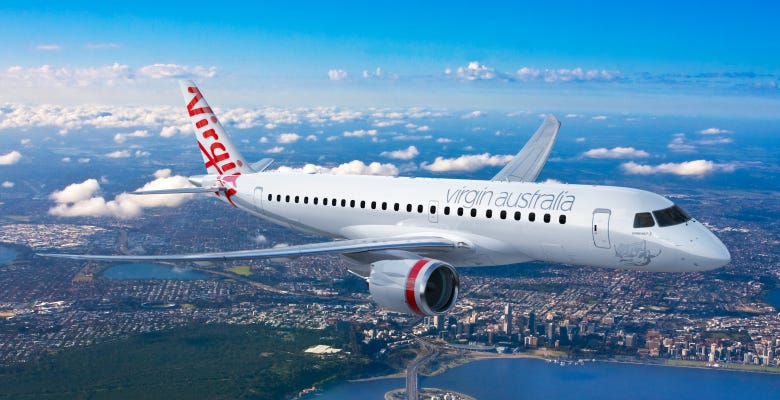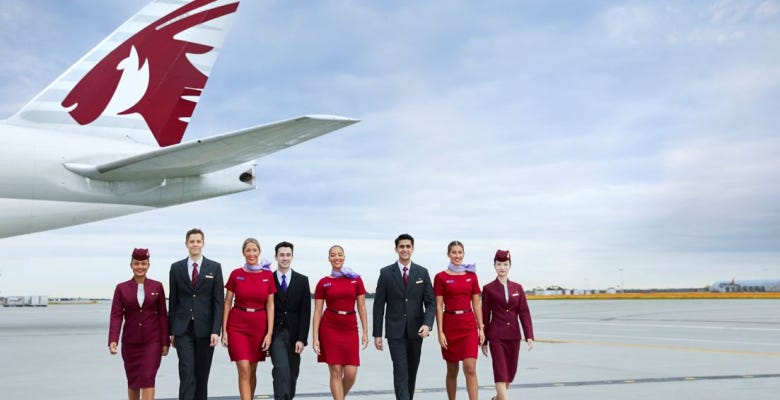What to expect from Virgin Australia in 2025?
Boeing delays and Qatar opportunities
Happy New Year to all our readers. Once again, thank you for your support and encouragement over the last year. We look forward to a productive and successful year ahead!
Analytic Flying is a free publication! We’re not selling anything; no ads and no credit cards sign-up links, but we do appreciate your support by sharing and subscribing. Subscriptions are free, but if you enjoy and value our content you can contribute with a paid subscription that helps defray the running costs. If you’re already a free subscriber and want to upgrade to a paid subscription just click on the link below!
We thought it would be a great way to start the year by looking ahead to what we might expect in the Australian commercial aviation market in 2025. We’ll do this in a series over posts over the next few weeks. Today we start with Virgin Australia, which has an exciting, promising and complicated year to look forward to!
This includes the expected completion of Qatar Airways’s acquisition of a 25% equity stake in Virgin, and the associated joint venture and wet-leasing arrangement that will enable Virgin to (kind of) restart long-haul flying. At the same time, Virgin is encountering huge challenges growing its short-haul fleet that promises to make it a difficult year. Let’s unpack …
Boeing delivery delays continue to dent short-haul growth
It is no secret that Virgin have been massacred by Boeing’s B737 Max delivery delays. They’ve already received 8x B737-8, with 18 more still on order. Of the 18, 6 are from an original tranche ordered in November 2023 and a further 12 that were converted from delayed B737-10s. The delivery timeline remains uncertain but some B737-8s are expected in 2nd half of 2025.
Virgin originally had ordered 14x B737-8s and 25x B737-10s, however due to further delays in the B737-10 program this was changed to 26 and 13 in September 2024. The B737-10 is now unlikely to be certified and delivered until late 2026 at the earliest. Delivery delays have significantly curtailed Virgin’s plans. Virgin even claimed that this contributed to the cancellation of Cairns-Haneda, however this was likely the least important factor. Other routes cancellations include Adelaide-Bali and contributed to Virgin cooling their interest in additional Bali route allocations.
Virgin have taken measures to mitigate fleet shortages. They have switched B737-10 orders for B737-8 as they’ll be delivered sooner. They’ve also taken on additional leased B737-800s. Virgin originally planned to take over 3 of Rex’s B737-800 leases, however only 2 eventualised (VJ-REX and RQP) with the 3rd falling through. They have since sourced a 3rd from Singapore Airlines (VH-IJR) that is due to enter service in the coming weeks.
This won’t be the first former Singapore 737 to join Virgin, with several having been leased in 2021 and 2022. It’s unknown whether VH-IJR is an ad hoc replacement for the 3rd Rex aircraft or a hint towards additional 737s from Singapore who have a handful due to be retired as their remaining B737-8s are delivered.
What to expect: Even if Virgin are able to take on a few more leased 737s the fleet will remain tight and limiting growth opportunities. Nevertheless, we’d expect Virgin to be opportunistic and pick up a handful of 737s during the year.
Regional, FIFO and the new Embraer E190-E2
It’s sometimes easy to forget that Virgin still have a regional subsidiary (Virgin Australia Regional Airlines), although they’re hardly a “regional” carrier as the name suggests. VARA operate 3x Fokker 100s and 7x leased A320s, a carry-over from Tiger Airways. VARA primarily service FIFO charter routes from Perth although the A320s occasionally venture east to provide cover for mainline services. A small number of regional services are flown under wetlease (e.g. Alliance Airways) and codeshare (e.g. Sydney-Canberra flights operated by Link Airways) arrangements rather than by VARA themselves.
In a surprising move, Virgin ordered 8x new Embraer E190-E2 for VARA in August last year. The aircraft will be based in Perth and replace the remaining Fokkers with deliveries expected to begin in October 2025. The surprise is not that Virgin are ordering E190s (again) having only retired their last E190 in 2018, rather that they’re ordering new aircraft for FIFO charters!
Historically, the FIFO business has been dominated by older aircraft. While older aircraft will have higher operating costs, their lower acquisition cost allows the aircraft to be operated at low/lower levels of utilisation. New aircraft must fly at high utilisation rates to earn their keep. For example, lease rates on a new E190-E2 might cost as much as US$ 250,000 per month with minimum lease period of 8 years. Meanwhile, a well-used A320 would cost less than US$100,000 per month with shorter lease terms available.
The high acquisition costs of new aircraft generates risk when having to reduce capacity in response to declining demand. It’s much cheaper or easier to park old aircraft that have been fully depreciated, or cancel leases with much lower carrying values. Airlines make up for the higher operating costs of the older aircraft as the FIFO revenue model is very different. Airlines enjoy fixed price contracts and aren’t subjected to fluctuations in prices and yields. However, they’re exposed to capacity risk as the fixed price contract can be terminated, reducing revenue to zero.
While the E190-E2s will be much cheaper to operate, they will cost a lot to acquire (lease or depreciation) and introduces risk. This indicates a degree of confidence from Virgin with a strong pipeline of work for the aircraft, whether that be FIFO, or supporting regional flying elsewhere in the network if needed. We suspect a bit of both!
What to expect: Too few E2s will be delivered before the end of 2025 to get much of a forward looking hint.
Virgin to restart long haul flying in 2025, well kinda!
At the beginning of October 2024, Virgin announced that Qatar Airways would acquire a 25% stake in Virgin and enter into a strategic partnership that would enable Virgin to restart long haul flying in 2025. This partnership is more complex than many commentators appreciate, and possibly even more obtuse. While it will likely be lucrative for Virgin it doesn’t imply a future long-haul roadmap. In essence, we argue that it’s entirely about Qatar’s need for market access and very little to do with Virgin’s interest in long-haul flying.
It’s no secret that Qatar have been seeking greater market access to Australia. Qatar are limited to 4x daily flights to Brisbane, Melbourne, Perth and Sydney, and sought to double this number in 2023, only to be controversially rebuffed by the Australian government. A lot was made of Qantas’s opposition to Qatar’s application but less regarding Virgin’s support for it. Back in September 2023, we highlighted that Virgin were inserting themselves in the process, with exaggerated claims of the impact on market capacity and prices.
Instead, Qatar have found another way. Qatar will wet-lease 4x B777-300ERs to Virgin that will fly between Brisbane, Melbourne, Perth and Sydney, and Doha under a joint venture arrangement. This will de facto achieve what Qatar sought out in the first place. There are several important details to clarify:
The equity investment, joint venture and wet-leasing arrangements are seperate and somewhat independent things. They could happen independently, but in this case they are interdependent. The equity investment is to be approved by the Foreign Investment Review Board, the joint venture by the ACCC and wet-leasing by CASA. Furthermore, Virgin will require route authority from the International Air Services Commission (IASC). ACCC has given the joint venture interim approval, allowing Virgin and Qatar to begin ticket sales.
Virgin will wet-lease the aircraft from Qatar, meaning that Qatar will provide the aircraft ready to go, including all crew, maintenance, insurance, etc. Qatar will be operating the flights for Virgin and the aircraft will remain on the Qatar register. Expect to find an aircraft in Qatar livery, crew in Qatar uniforms, providing Qatar service (we’ve heard rumours that they may paint some of the aircraft in Virgin livery). This is different from a dry, operating or finance lease where Virgin would operate the aircraft with their own crew and be responsible for all maintenance, insurance, etc. Typically, wet-leasing is used as a temporary measure to cover existing flying due to a fleet shortage, e.g. Qantas wet-leasing 2x Finnair A330s for a 2 year period, or Air New Zealand wet-leasing an A330 from Wamos to provide some cover for grounded B787s.
A joint venture isn’t a codeshare. It’s a lot more than a codeshare. The approval that Virgin and Qatar have jointly sought from the ACCC is to coordinate scheduling, pricing and ticketing. Under a typical codeshare, the carriers operate independently. One airline sells capacity to the other carrier for an agreed price and then that carrier sells on the capacity as their own under their own terms. Under a joint venture, the carriers combine the capacity and sell it together. Essentially, Qatar will have full access to all of Virgin’s capacity on these flights between Australia and Doha, and conceptually could utilise and sell all of it under the QR code. Given that this wet-leasing will be provided by Qatar, it’s tantamount to these “Virgin” flights being thought of as “Qatar, operated by Virgin, operated by Qatar”, a tongue in cheek reference to the way codeshare flights would typically be labeled (i.e. Qantas operated by Sri Lankan Airlines).
This is an exceptionally clever way that Qatar are gaining access to additional capacity. One might ague that it’s costing them a lot as they are having to share their spoils with Virgin, however the acquisition of the equity stake means that they will ensure it’s not in vain. Virgin would happily move forward with the deal without the equity stake, as the joint venture and wet-lease would be sufficient for them, however it’s likely that the equity stake is required by Qatar to ensure the cost of this access isn’t too high. Qatar are also gaining access to Virgin’s customer base (see final paragraph for more on this).
The deal is unusual in that wet-leasing isn’t typically used for long term capacity or to open new routes, at least not in countries with well-developed aviation sectors. Virgin have not placed an explicit timeline on the length of the wet-lease like Qantas did with Finnair. We might consider the ACCC application as automatically setting this at 5 years since this is the typical length of time that joint ventures are approved for. Airlines must reapply every 5 years and approval isn’t guaranteed as we saw when the ACCC blocked the extension of the Qantas-China Eastern joint venture.
Virgin have countered this by arguing that restarting long-haul operations is risky (it certainly is) and that this arrangement reduces the risk (it certainly does). They’ve argued that acquiring widebody aircraft in the current market is difficult and sourcing the appropriate aircraft without paying an unnecessary premium would be very difficult, likely delaying a long-haul restart several years (this is also true).
These are compelling arguments, however one must consider the counterfactual. Even if the widebody aircraft market weren’t so tight, would Virgin be restarting long-haul operations on their own metal? Many are doubtful regarding this. While long-haul flying can be lucrative it comes with far more risks than short-haul flying and would be a questionable allocation of scarce capital given their short haul-fleet constraints.
The utilisation of wet-leasing on an indefinite basis has led to calls by the AIPA pilots unions for regulators to place conditions on it, limiting the timeline that wet-leasing can be utilised. This will force Virgin to consider their own widebody aircraft, or at least convert wet-leases into dry-leases by some point in the future.
The Virgin-Qatar joint venture has also raised other objections and its approval by the ACCC is likely to include several conditions. Firstly, joint ventures are typically approved subject to maintaining pre-JV capacity. This application is unusual in that it proposes a very large increase in capacity. As we’ve previously argued, Qatar’s initial strategy in 2023 was less about capacity and more about frequency, ensuring that their 2nd or 3rd daily flight would connect into an alternative connecting bank in Doha.
Since the interim approval by the ACCC we’ve already seen significant schedule changes of Qatar’s original flights that focus on concerns. This includes Qatar shifting the Adelaide-Melbourne ghost flight to Canberra, but also reducing capacity on Doha-Perth, downgrading the A380 to the B777-300ER for a several month stretch. It’s likely that ACCC will set some ground rules for Qatar and Virgin’s ability to manage capacity, and hopefully ensuring they keep to their commitments. As we’ve seen before, they’ve been a little too happy to exaggerate.
Secondly, the deal has led to Virgin making big changes to the Velocity programme in favour of Qatar. We might go as far as calling it a loyalty oath to Qatar! This has seen them removing Etihad as a partner and placing (confusing) limits on other partners. It’s possible that the ACCC may place conditions to limit such actions but several changes have already been made. Rather, we might consider how partner airlines might react.
For example, Virgin have significantly limited milage and status earning on Singapore Airlines (particularly to Europe), thereby reducing Singapore’s access to Velocity’s customer base. Will Singapore respond in a tit-for-tat manner and reducing Virgin’s access to Singapore’s Asian network? This might me more costly for Virgin than it would for Singapore as Virgin need Singapore’s network to effectively compete for customers with Qantas, similarly to how they utilise United as a competitive counterpoint to the US. While everyone is focused in Qantas’s reaction, we’d be more interested in the reaction of other carriers, like Singapore and even Emirates.
What to expect: Conditions, conditions, conditions! And WWSQD?
2025 will be an interesting year for Virgin. While so much attention will be on Virgin’s long-haul rollout, the challenge will be squarely on maintaining and growing short-haul capacity in the face of a challenging fleet scenario. Later this week we’ll turn out attention to Qantas and Jetstar, reviewing an equally interesting, but very different year ahead.





